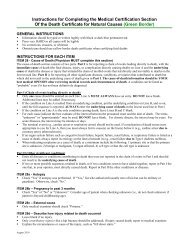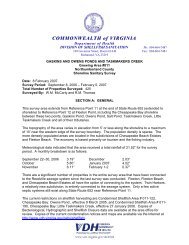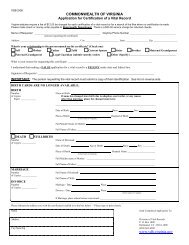Lyme Disease
Lyme Disease
Lyme Disease
Create successful ePaper yourself
Turn your PDF publications into a flip-book with our unique Google optimized e-Paper software.
Spring and summer bring warm temperatures, just right forwalking in the woods and other outdoor activities. Warmweather also means that ticks become more active and this canincrease the risk of a tick-borne disease. The tick-borne diseasesthat occur most often in Virginia are <strong>Lyme</strong> disease,Rocky Mountain spotted fever, and ehrlichiosis.<strong>Lyme</strong> <strong>Disease</strong><strong>Lyme</strong> disease is caused by infection with a bacterium calledBorrelia burgdorferi. The number of <strong>Lyme</strong> disease casesreported in Virginia has increased substantially in recent years.The TickThe blacklegged tick (Ixodes scapularis), formerly known asthe deer tick, is the only carrier of <strong>Lyme</strong> disease in the EasternU.S. The blacklegged tick's name comes from it being the onlytick in the Eastern U.S. that bites humans and has legs that areblack (or dark chocolate brown) in color.<strong>Lyme</strong> disease transmission to humans usually occurs duringthe late spring and early summer when young (nymph stage)ticks are active and feeding. Tick nymphs normally feed onEM Rashsmall and medium sized animals, but will also feed on people.These ticks typically become infected with the <strong>Lyme</strong> diseaseagent by feeding as larvae on certain rodent species.In the fall, the nymphs become adults and infected nymphsbecome infected adults. Adult blacklegged ticks prefer to feedon deer. However, adult ticks will occasionally bite people onwarm days of the fall and winter and can transmit <strong>Lyme</strong> diseaseat that time.Transmission of <strong>Lyme</strong> disease by the nymph or adult ticksdoes not occur until the tick has been attached and feeding ona human or animal host for at least 36 hours.The SymptomsBetween three days to several weeks after being bitten by aninfected tick, 70-90% of people develop a circular or oval rash,called erythema migrans (or EM), at the site of the bite. To qualifyas an EM, the rash must be at least two inches in diameter.That is because bites by some tick species can cause localinflammation and redness around the bite that could be mistakenfor an EM. Unlike localized inflammation, an EM rash willincrease in size and may become more than 12 inches across. Asit enlarges, the area around the center of the rash clears, givingit a “bull's eye” appearance. The EM rash does not itch or hurtso if it is not seen, it may not be noticed. In addition to an EMrash, <strong>Lyme</strong> disease may cause headache, fever, muscle and jointaches, and a feeling of tiredness. If left untreated, <strong>Lyme</strong> diseasemay progress to affect the joints, nervous system, or heart severalweeks to months after the tick bite. In a small percentage ofinfected people, late symptoms may occur months to years laterand cause long-term nervous system problems or arthritis.
Unfortunately, blacklegged tick nymphs are small (about thesize of a pinhead), difficult to see, and cause no itch or irritationat the site of the bite, so many people are not aware theyhave been bitten. If you have been in an area that might containticks and you experience any symptoms of <strong>Lyme</strong> disease,contact your doctor.The TreatmentWhen <strong>Lyme</strong> disease is detected early, its effects can be mildand easily treated with antibiotics. In the late stages, <strong>Lyme</strong> diseasecan be treated successfully with antibiotics, but recoverymay take considerably longer.Rocky Mountain Spotted FeverRocky Mountain spotted fever (RMSF) is caused by infectionwith a bacterium called Rickettsia rickettsii. The disease is characterizedby a sudden onset of symptoms and can be fatal if nottreated. Nearly all cases occur in the spring and summer months.The TickIn Virginia, the American dog tick (Dermacentor variabilis) isthe species known to carry the agent of Rocky Mountain spottedfever. The tick needs to feed on a host/person for onlyabout four hours to transmit the bacteria. Fortunately, less than1% of American dog ticks carry the agent of RMSF.The SymptomsSymptoms of Rocky Mountain spotted fever begin 2-14 daysafter the tick bite, and may include fever, deep muscle pain,severe headache, chills, and upset stomach or vomiting.From the third to fifth day of illness a red, spotted rash mayappear, beginning on the wrists and ankles. The rash spreadsquickly to the palms of the hands and soles of the feet and thento the rest of the body. However, only about half of RMSFpatients develop a rash.The TreatmentAntibiotic treatment for RMSF is effective, and suspectedRMSF should be treated as soon as possible based on symptomsand a history of tick exposure. The risk of death fromRMSF increases by the fifth day of illness - but the rash oftendoes not occur until that time. Therefore, do not wait forRMSF blood test results, or the appearance of a rash, beforestarting treatment. Treatment is important; almost one-third ofthose who do not get treated die from this disease.Ehrlichiosis and AnaplasmosisAlthough several diseases can be caused by bacteria in theEhrlichia and Anaplasma genera, the most common in Virginiaare human monocytic ehrlichiosis (HME) and human granulocyticanaplasmosis (HGA). HME is transmitted only by thelone star tick (Amblyomma americanum) and most commonlyby bites from adult ticks. Lone star ticks are very common andare responsible for the most tick bites to people in Virginia.HGA is transmitted only by the blacklegged tick (most commonlyby bites from nymphal stage ticks). The bacteria causingHME or HGA will not be transmitted unless the infectedtick has been attached and feeding for at least 24 hours.The SymptomsSymptoms for both HME and HGA can include fever, headache,muscle pain, vomiting, and general discomfort. Illness can besevere - up to 3% of patients may die if not treated.The TreatmentHME and HGA respond rapidly to treatment with antibiotics.Treatment should be based on symptoms (including plateletand liver enzyme tests) and history of tick exposure. Treatmentshould not be delayed while waiting for ehrlichiosis- oranaplasmosis-specific serology results.Other <strong>Disease</strong>sTicks can transmit other diseases, such as tularemia (rabbit fever)and babesiosis. Neither of these illnesses is common in Virginia.Tularemia is a bacterial disease that has a sudden onset of feverand chills. Typically, an ulcer develops at the site of the tickbite and surrounding lymph nodes become enlarged. Tularemiais a serious illness and untreated cases may be fatal. Tularemiais most commonly associated with the American dog tick, butmay also be transmitted by the lone star tick.Spotted rash on arm and hand of RMSF patient.Babesiosis is caused by a parasite that infects red blood cells.The babesiosis agent is transmitted only by infected black-
Tick Identification ChartOriginal image by Litwak for CDC; modified by D.N. Gaines for VDH.Tick-borne <strong>Disease</strong> ChartTick-borne <strong>Disease</strong>s Anaplasmosis Ehrlichiosis Babesiosis<strong>Lyme</strong><strong>Disease</strong>RockyMountainSpotted FeverTularemiaBlacklegged TickIxodes scapularisLone Star TickAmblyomma americanumVector Vector VectorVectorVectorAmerican Dog TickDermacentor variabilisTick Stage that Transmits theMost <strong>Disease</strong> to PeopleVectorNymph Adult Nymph Nymph Adult OnlyVectorNymph orAdultMinimum Feeding Time for<strong>Disease</strong> Transmission24 hours 24 hours 36 hours 36 hours 4-6 hours Not knownFor more information on tick-borne diseases, visit www.vdh.virginia.gov/TickBrochure. June 2010
legged ticks. Symptoms include fever, chills, muscle aches,fatigue, and jaundice. Fatalities may occur in immuno-compromisedor splenectomized patients.PreventionTicks do not jump or fly; they wait on the forest floor, leaf litter,or low vegetation and attach to the feet or shoes of peopleor legs of animals as they pass by. The ticks then crawl upward.The following steps can reduce your risk of tick-borne diseases:• Avoid potential tick habitats such as tall grass and vegetationin shaded areas, forests, and along forest edges.• Walk in the center of mowed trails to avoid brushingagainst vegetation.• Keep grass cut and underbrush thinned in yards. If pesticidesare used for tick control, follow directions carefullyor hire a professional to apply the pesticide.• Eliminate wood piles and objects that provide cover andnesting sites for small rodents around your property.• Wear light-colored clothing so that ticks are easier to seeand remove.• Tuck pant legs into socks and boots, tuck shirts into pants,and wear long-sleeved shirts buttoned at the wrist.• Conduct tick checks on yourself and your children everyfour to six hours while in tick habitat.• Apply tick repellent to areas of the body and clothing thatmay come in contact with grass and brush. Repellentsinclude those containing up to 50% DEET for adults or lessthan 30% for children. An aerosol repellent/insecticide containing0.5% permethrin may be applied to shoes, socks, andother clothing, but should not be used on skin. Follow directionscarefully and do not overuse. Some tick repellents cancause toxic or allergic reactions.• Ask your veterinarian to recommend tick control methodsfor your pets. Animals can get <strong>Lyme</strong> disease, RockyMountain spotted fever, and ehrlichiosis, but they do nottransmit these diseases to humans.Tick RemovalBecause ticks do not transmit disease until they have beenattached to the host for several hours or several days, it is veryimportant to remove ticks as soon as they are found. The followingis the best way to remove a tick:• Grasp the tick with tweezers as close to the skin as possibleand gently, but firmly, pull it straight out. Avoid any twistingor jerking motion that may break off the mouth parts inthe skin. Mouth parts left in the wound may cause irritationor infection similar to a reaction from a splinter.• If tweezers are not available, protect your fingers withgloves, tissue, or a paper towel; do not touch the tick withbare fingers. Do not squeeze or rupture the tick's swollenabdomen. This may cause an infectious agent to contaminatethe bite site and cause disease.• After the tick has been removed, wash hands with soapand water. Apply a topical antiseptic to the bite site.• You can dispose of the tick by drowning it in alcohol orflushing it down a drain or toilet. However, it may be usefulto save the tick in alcohol for several weeks and haveit identified by an expert in case you become ill. Knowingwhat kind of tick bit you might help your doctor diagnosethe illness..• Tick removal using nail polish, petroleum jelly, alcohol ora hot match is not safe. These methods could cause the tickto regurgitate an infectious agent into the site of the bite.If you get sick, and you have been exposed to ticks, be sure to tell your doctor about your tick exposure.For more information, visit our website at:www.vdh.virginia.gov/epidemiology/DEE/Vectorborne/index.htmwww.vdh.virginia.govApril 2010
















